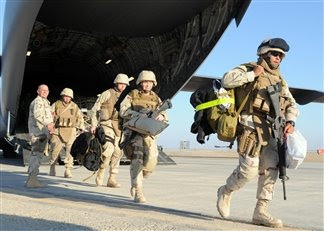 President Barack Obama has ordered the deployment of 17,000 additional American troops to Afghanistan. This will bring the total number of U.S. forces in the country to almost 50,000. While that sounds like a formidable force, when you look at the command structure in place in Afghanistan, it is not the case.
President Barack Obama has ordered the deployment of 17,000 additional American troops to Afghanistan. This will bring the total number of U.S. forces in the country to almost 50,000. While that sounds like a formidable force, when you look at the command structure in place in Afghanistan, it is not the case.
The 32,000 American troops in country now are not all under American command. Almost half - 14,000 - are assigned to NATO's force of 50,000 troops. Effectively, they are not American troops, but NATO troops.
Anyone who has ever served with or dealt with (I have) NATO realizes what that means: bureaucracy and inefficiency raised to an art form. One only hopes that the additional American forces are being assigned to the American-led coalition force commanded by an American general and not to the NATO force.
There are multiple problems with the NATO force in Afghanistan. Among them is the fact that NATO forces are commanded from Belgium, and there are numerous restrictions - the "rules of engagement" - on the employment of troops imposed by the host countries. For example, German forces in the country are severely restricted in engaging the enemy. See my earlier article, German soldiers in Afghanistan - don't shoot the bad guys!. The presence of a NATO force separate from the coalition force led by a U.S. Central Command (CENTCOM) general creates operational problems. NATO units - including the 14,000 American assigned to NATO in Afghanistan - receive orders via the NATO command in Belgium.
The presence of a NATO force separate from the coalition force led by a U.S. Central Command (CENTCOM) general creates operational problems. NATO units - including the 14,000 American assigned to NATO in Afghanistan - receive orders via the NATO command in Belgium.
American units assigned to the American-led coalition receive orders from CENTCOM, while Afghan National Army units are separate from both NATO and CENTCOM (see chart). Anyone who has attended any military staff college anywhere will recognize the problems with this arrangement. See my earlier article, American troops in Afghanistan deserve a better command structure.
The troop increase is part of an ongoing review of American operations in Afghanistan. That review should address the broken command structure - someone has to be in overall command. Given the U.S. commitment in terms of troops and resources, it makes sense that the American force commander should be directing all military operations in the country.
The review should also address the paltry commitments by many of our NATO allies. The troops doing almost all of the fighting are the Americans, British, Canadians, Dutch and Polish. If NATO is to be an effective organization in the future, it has to function effectively now.
American commanders want to double the 17,000 troop increase. Perhaps if there was a workable command structure and a bit more commitment on the part of our allies, that number may not need to be so high.

.jpg)
